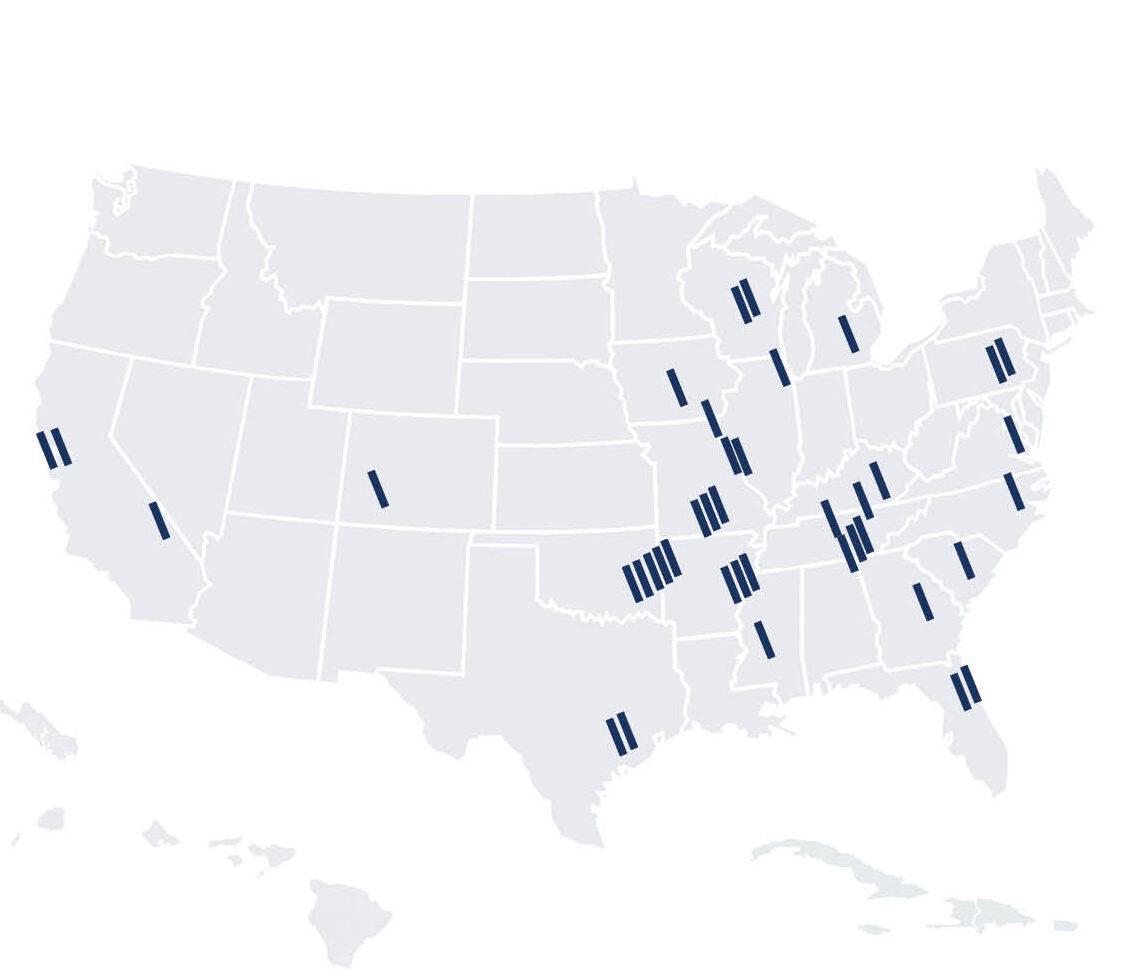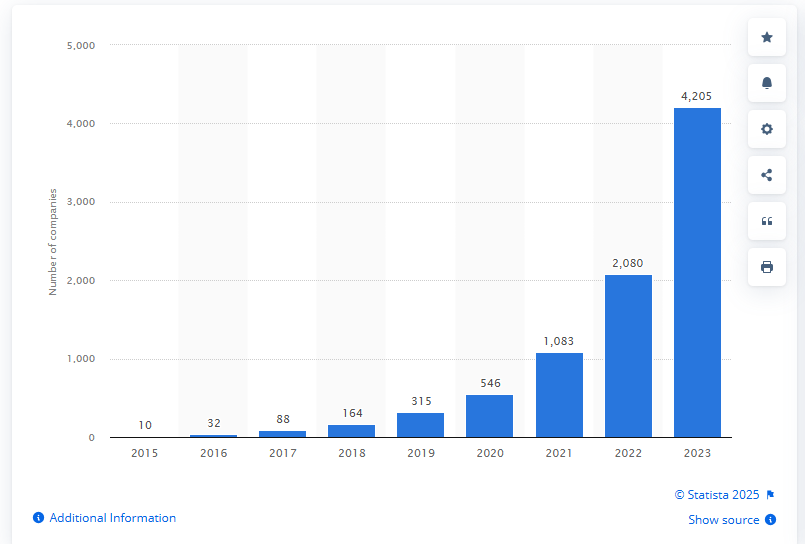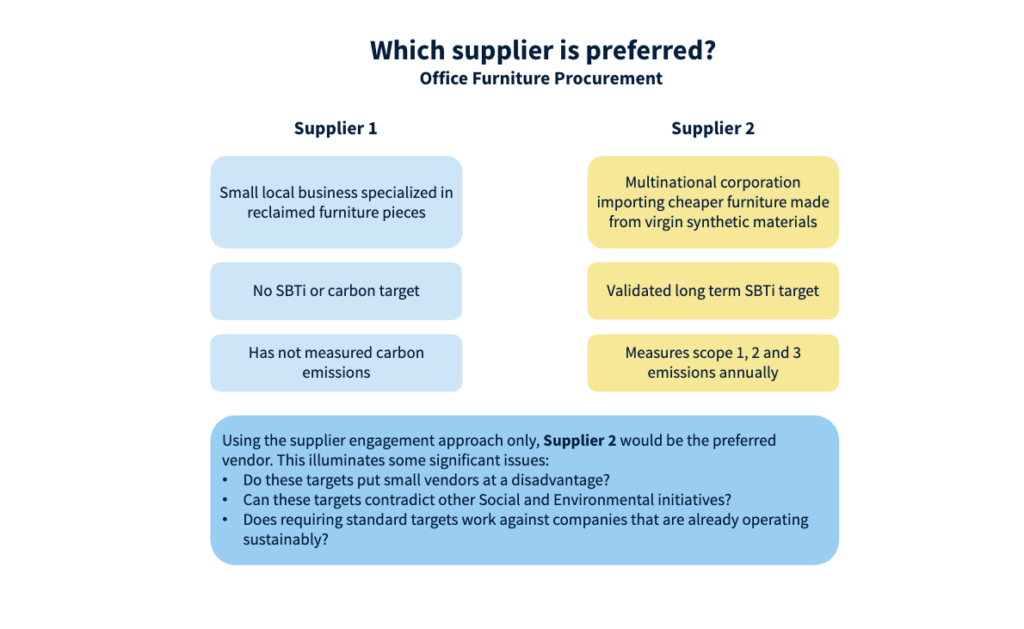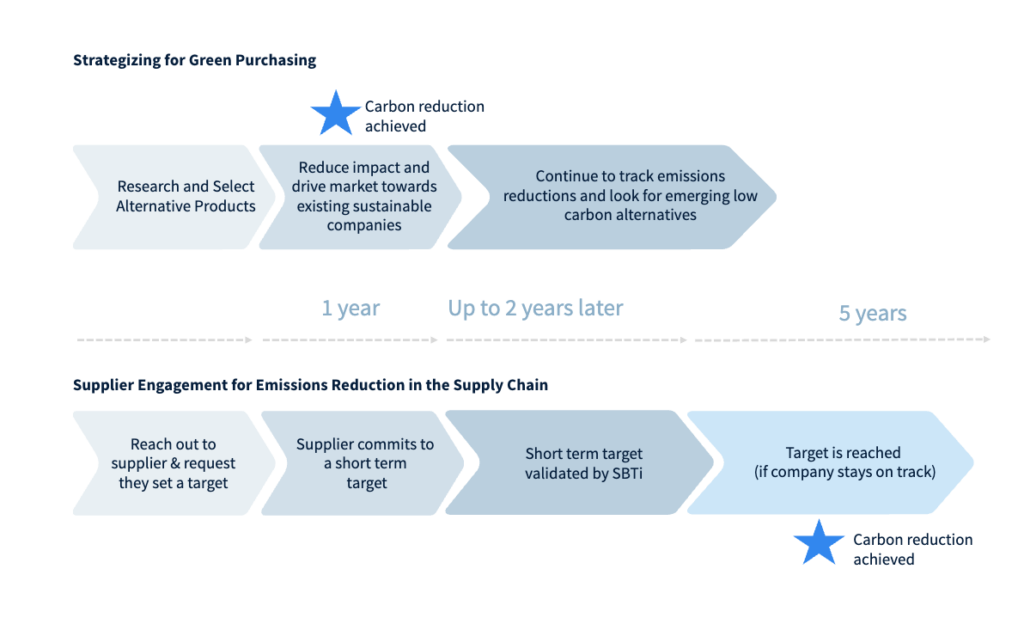Rethinking Scope 3 Emissions Strategies
Driving Real Supply Chain Emissions Reductions: An Examination of Large Corporations and Common Scope 3 Strategies
- ESG + Corporate Sustainability
Practices Engaged
- Scope 3
- Supply Chain Engagement
- Sustainability Reporting & ESG Disclosure
Services Delivered
- Data Center Manufacturing
Industry Sectors

Driving Real Supply Chain Emissions Reductions: An Examination of Large Corporations and Common Scope 3 StrategiesAs climate pressures intensify, companies are feeling the urgency to set and achieve ambitious carbon reduction targets. Scope 3 emissions, from a company’s upstream and downstream indirect activities, typically make up the vast majority of emissions, far outweighing emissions from energy usage (scope 1 and 2 emissions). Supply chains are complex and elusive, and the associated emissions are equally as cumbersome. As we near the end of the first wave of industry leading Fortune 100 and 500 companies setting targets, there are some valuable lessons to learn and heed as best practice. It is important to note that the intention of this article is not to discourage companies from tackling scope 3 emissions, in fact, it is the opposite. We want to support companies by designing programs that are high impact and equitable, driving immediate carbon reductions and not requiring either the reporting company or companies in the supply chain to spend large portions of their sustainability budgets on reporting and data chasing.
Cumulative number of companies with science-based approved targets and commitments worldwide from 2015 to 2023. Image from Ian Tiseo, Statista, 2025. Many organizations turn to the Science-Based Targets initiative (SBTi) as the “gold standard” for aligning corporate emissions reductions with a 1.5°C future. Companies utilizing this standard often adopt ambitious goals, such as reducing emissions 42% across scopes 1, 2, and 3 by 2030. To meet the scope 3 portion of this target, many large companies require their vendors to set similar goals and commit to SBTi standards. The underlying assumption is that if all companies collectively cut their baseline emissions in half, it would help maintain alignment with the 1.5°C climate target. SBTi Supplier Engagement Guidance notes, “Supplier engagement targets offer a way to influence decarbonization efforts within companies’ supply chain when granular emissions data is challenging to track or unavailable. These targets focus on engaging a defined set of suppliers in the near-term to set their own science-based targets on all applicable scopes and categories.” But is this approach really driving carbon reductions? At first glance, the strategy seems sound: if a large portion of suppliers within a value chain commit to reducing their emissions by half, the collective result should be alignment with global climate goals. However, carbon emissions are a nuanced topic and carbon footprints vary widely from company to company. A corporation with numerous building locations might achieve a 50% emissions reduction by installing solar panels onsite at each location, which is a straightforward solution. In contrast, a professional services company, where 90% of emissions stem from cloud storage and the purchase of employee computers, will face a much more complex challenge. Setting a blanket “one-size-fits-all” requirement for all vendors regardless of size or industry is not equitable or effective. Companies may inadvertently burden smaller vendors, waste resources on administrative tasks, or fail to drive substantial carbon reductions. For many small suppliers, setting emissions targets and developing decarbonization plans can be prohibitively expensive, and may not prove to be the most effective way to reduce carbon for their industry or company size.
Reevaluating Supply Chain Engagement StrategiesFor companies relying on supplier engagement targets—such as requiring all vendors to reduce emissions by 55% by 2030—there are critical challenges to consider. Note that many supplier engagement programs can be effective, and the emphasis on purchasing power and influence here is targeted at mega corporations with an annual revenue of more than $1 billion. 1. THE ROLE OF MEGA RETAILERS IN EMISSIONS TARGETS A company that refers to its annual spend by vendor to identify suppliers to engage may make the common mistake of targeting a retailer, rather than a manufacturer or supplier. Mega retailers setting a carbon reduction target does not directly impact the actual product purchased. For example, if Company A buys printer paper from a mega retailer, it may inadvertently focus on the retailer’s carbon reduction target rather than the manufacturer of the paper itself. This creates an indirect and lengthy connection between Company A’s carbon reduction efforts and the actual environmental impact of the printer paper. Will the retailer’s target indirectly encourage the paper manufacturer to switch to producing a lower carbon paper product? Possibly, but this is a long and inefficient path to achieve meaningful change. Mistake #1: Company A Targets Mega Distributor Instead of Actual Supplier
2. TIME CONSUMING TARGET SETTING VS. INSTANT PURCHASING POWER Continuing with the printer paper example, imagine Company A purchases paper directly from the manufacturer. If Company A follows a supply chain engagement target (aligned with the current requirements of one of the biggest tech companies), it would require the paper manufacturer to measure its scope 1, 2, and 3 emissions, develop a decarbonization plan, set reduction targets, engage its own supply chain, track progress, and ultimately cut emissions by 55%. This process could take five years or more. Alternatively, Company A could use its purchasing power to switch immediately to paper made from 100% recycled materials.
3. “LIBERTY MEANS RESPONSIBILITY. THAT IS WHY MOST MEN DREAD IT.” -GEORGE BERNARD SHAW The above example highlighted a simple emissions reduction scenario by comparing products made from recycled versus virgin materials. But what happens when the vendor is a small IT Consulting firm with under 50 remote employees or a small landscape architecture firm designing exterior spaces for a large corporation? For professional services companies like these, an average of 90% or more of their emissions typically come from their own purchased goods and services. With a supply chain engagement target, the large corporation shifts the responsibility for sustainable procurement onto these smaller vendors, who often have far less capital and purchasing power. How instead could the large corporation work with micro suppliers to design more sustainable projects and systems with innovative materials? For example: Let’s revisit the landscape architecture firm. Eighty percent or more of its emissions stem from ongoing purchasing such as office supplies and employee computers. Should this small company focus its limited sustainability resources—perhaps only $2,000, a number we hear often—on tracking and reporting emissions or chasing more accurate vendor data? These activities alone could consume its entire budget, leaving no funds for research and development, staff training, or exploring low carbon design solutions for projects. This is a common occurrence. Just this year, one prominent technology company referred small to medium suppliers to report emissions using two software companies that charged upwards of $2,000-$6,000 per submission, giving those suppliers less than two months to submit (and pay). For a small business, this type of unexpected expense can be devastating, and almost certainly removes the possibility of further spending on climate action. Importantly, for those who do not care as deeply about mitigating climate change as others, it can create ill-will toward the climate action movement, influencing our communities to re-frame a business opportunity to contribute positively to society as a costly compliance annoyance. A recent study from the Imperial College London, published August 8th, 2024, found that “73 percent of surveyed EU citizens said the environmental impact of a product is ‘very important’… they often fail to act on these principles.” Crafting a More Effective Scope 3 StrategyTo create meaningful and impactful scope 3 reductions, it is essential to focus on strategic approaches that align with targeting high-emission sectors, focusing efforts on the necessary and useful data, and tailoring solutions to a company’s unique footprint. Here are key strategies for real change. 1. TARGET HIGH-EMISSIONS SECTORS High-emissions sectors such as building materials and data centers should be prioritized for scope 3 strategies. These sectors have higher emissions per dollar spent than professional services or others. While professional services’ targets may not lead to immediate or drastic industry changes, ambitious requirements in these high-emissions sectors can create decarbonization opportunities for this sector, driving the market towards more sustainable materials and products. If a company is trying to reduce remissions by 400 MTCO2e, should these two groups of vendors be given the same requirements and targets?
2. ALIGN DATA IMPROVEMENT WITH PROGRESS “You can’t manage what you don’t measure” is a phrase we hear at Brightworks time and again in the quest for understanding the true and actual carbon emissions of a company. While this statement is true—to understand impact, a baseline is paramount—the last goal should not be to capture a 100% accurate product or supplier specific emissions factor for every single line item purchased within a year. Instead, focus on implementing these reduction-oriented policies first, or in tandem with data improvement efforts:
Many companies we speak with are stressed about the enforcement of such policies and potential risk involved to their business in doing so. Enforcement does not have to mean you will stop working with suppliers who do not comply. We like what Nobel-prize winning economist Elinor Ostrom offers on creating and enforcing graduated sanctions for rule-breakers in her classic text Governing the Commons. As she highlights, incentives for your suppliers tend to work even better. It’s worth noting here that incentivizing suppliers and driving market change works well for large companies spending significant money with vendors. For smaller companies, alternative methods of engagement and policy development will need to be explored. 3. MOVE AWAY FROM ONE-SIZE-FITS-ALL STRATEGIES Tailored solutions are more effective than one-size-fits-all strategies. For example, take the landscape architect whose footprint largely stems from purchases like office supplies and computers. Tracking emissions annually and engaging with their supply chain is costly and time-consuming for a small company with no dedicated sustainability staff. Instead, the large reporting company could invest in a low carbon design for a project. This could include using innovative recycled materials or native plants with high carbon sequestration potential. Let the large corporation help the landscape architect to allocate their sustainably budget to these efforts, rather than only the paperwork of annual reporting. By supporting these sustainable initiatives, large companies can help smaller vendors gain valuable experience and integrate these efforts into their standard practices. This creates a ripple effect, where the vendor can use their new knowledge to implement low carbon solutions for future clients, thereby amplifying impact.
Addressing Scope 3 emissions is essential for achieving meaningful climate impact. By focusing on crafting more effective strategies, companies can drive real progress toward their carbon reduction goals. For more information on how your organization can develop a practical and effective emissions measurement and reduction strategy, reach out to Erin Hocking, Corporate Reporting & Strategy Service Lead at Brightworks Sustainability, here. Written by Erin Hocking, Corporate Reporting & Strategy Service Lead, Brightworks Sustainability |


Starwood Hotels & Resorts
1 Hotel Hanalei Bay Luxury Resort
Starwood Hotels & Resorts
1 Hotel Hanalei Bay Luxury Resort
Princeville, HI
Brightworks provided LEED certification management and energy services to support Starwood Hotels with the major renovation and rebranding of Kauai’s Princeville Hotel into a flagship 1 Hotel resort focused on sustainable hospitality and wellness. Brightworks collaborated with the design and construction team to incorporate innovative strategies that will save energy and water, improve operations, and protect local ecosystems. Brightworks also delivered comprehensive energy modeling services, which allowed the project team to identify energy conservation measures and evaluate options.
Practices Engaged:
Sustainable Built Environments
Industry Sectors:
Hotel
Building Types:
Hotels & Resorts


Gerding Edlen
5 MLK Apartments
Gerding Edlen
5 MLK Apartments
Portland, OR
This biophilically-designed tower achieved LEED Gold and Fitwel 1 Star certification while also featuring a resiliency program. The building offers 100,000 square feet of offices on lower floors and 220 residential units with landscaped terraces above.
Practices Engaged:
Sustainable Built Environments, Healthier Built Environments
Industry Sectors:
Residential
Building Types:
Luxury Residential


City of Portland
Case Study
City of Portland
Case Study
Practices Engaged:
Healthier Built Environments
Industry Sectors:
Corporate, Government, State & Local
Building Types:
Historic Buildings
Read more


ABB
North American GreenCRREM Assessments
ABB
North American GreenCRREM Assessments
Arkansas, California, Florida, Georgia, Michican, Missouri, Mississippi, North Carolina, New Jersey, New Mexico, Oklahoma, Pennsylvania, South Carolina, Tennessee, Texas, Virginia, Wisconsin, West Virginia
ABB is a global leader in industrial technology. Across 17 states, Brightworks conducted sustainability assessments on more than 50 buildings in ABB's North American portfolio, including manufacturing, office, and warehousing facilities. An extensive report providing a baseline assessment for each site helped ABB prioritize energy efficiency measures, budget for carbon reduction efforts, and calculate ROI as part of its GreenCRREM program.
Practices Engaged:
Sustainable Built Environments, Carbon, Energy
Industry Sectors:
Corporate, Manufacturing


Salesforce
Case Study
Salesforce
Case Study
This letter to the industry highlights the urgent need to address embodied carbon in MEP/IT/AV systems. While operational emissions have seen progress, this embodied carbon remains a challenge. This article reveals insights to guide the industry toward a 50% reduction by 2030 to stay on track for meeting net-zero carbon targets for 2050.
Practices Engaged:
ESG + Corporate Sustainability, Sustainable Built Environments, Carbon, Materials
Read more


AI Meets Lower Carbon Concrete
AI Meets Lower Carbon Concrete
Concrete accounts for 8% of global GHG emissions, which is more than every country except the US and China. Lower carbon concrete is a critical climate solution, but designing it isn’t simple. While AI offers promise, experts warn of its limitations in capturing real-world variables. This post explores why human expertise still leads the way, and how integrative strategies are reshaping concrete’s future.
Practices Engaged:
Materials
Read more

-
U.S. GSA Diplomatic Security OfficeDiplomatic Security Office | Seattle, WA
-
U.S. Social Security Administration OfficeVan Nuys Office | CA

 This article explores the pitfalls of current supply chain engagement strategies and offers a roadmap to allow scope 3 emissions programs to drive real, measurable change—efficiently and equitably.
This article explores the pitfalls of current supply chain engagement strategies and offers a roadmap to allow scope 3 emissions programs to drive real, measurable change—efficiently and equitably.


